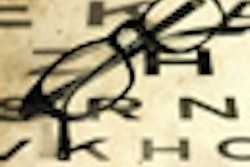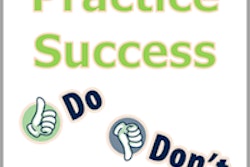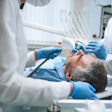Editor's note: Sheri Doniger's column, Dental Diaries, appears regularly on the DrBicuspid.com advice and opinion page, Second Opinion.
I love my profession. I enjoy seeing my patients. I especially enjoy the ability to calm down that "white knuckler" patient who hasn't seen a dentist for several years due to a horrific experience in childhood, early adulthood, mid adulthood, or late adulthood. I take care in my processes to ensure that my patients are comfortable and relaxed due to systems we have put into place over the years.
In fact, this is the real reason I became a dentist: I was deathly afraid of being in the chair myself. In my youth, I had to be basically restrained to have my teeth cleaned. Laugh if you must, but it was not pleasant. Yes, it is funny now, considering my chosen profession, but at the time, when I was a terrorized young child in a dental chair with a dentist who didn't care about the comfort of patients, it wasn't funny. I became a dental hygienist at the gentle prodding of a periodontist who saw something in my dental assisting skills. During dental hygiene school, I decided to go the distance and become a dentist because I knew I would be able to do more working with the patient as a dentist.
As we know, what is past is prologue. I recently had some sensitivity in my maxillary left quadrant. I have been monitoring it for a while, with preventive visits and radiographs, but it became more pronounced a few months ago. I went to a colleague who had previously done some restorative work on me. Now, remember, I am still not the best patient and walked into his office with my own topical. He laughed and said he rarely uses the stuff. Well, I said, I will be one of those rare patients. As a bonus, I did get some firsthand experience with a product I use on my patients. The old amalgam was removed and temporized, and I went on my way.
Although my colleague wanted me to see what was going on, I preferred to let him be the dentist and me the patient. Each dentist has his or her own systems. Each dentist decides how to manage their practice and which techniques to utilize. Many dentists who have solo practices decide how they best prefer to manage their practices, along with research from noted practice managers and colleague recommendations. I, for one, take only one patient at a time. To most practice managers, this is not an effective style of practice. To me, I prefer the personal level of patient interaction and give up some production for the time. As a dentist, being a patient in another person's practice, it allows us to review our systems and compare them to our colleagues.
Referred out
To make a typical restorative long story short, there were several roadblocks on the way to my dental bliss. Remember Mr. Murphy and his law? That was my tooth! My decay has historically been very deep. The tooth had a carious exposure (noted prior to a final impression being taken). And I was off to the endodontist. I had the option to stay with my dentist to perform the procedure, but I wanted to experience the endodontist we have been referring to for the past 20 years.
Aside from the trepidation of devitalizing a pulp, I did manage to hide my nervousness. When my patients had asked me why I do not perform endodontic procedures, my usual answer was always: They do it all day long and are much faster than I would be. Truer words have not been spoken. As a dentist knowing what is happening during an endodontic appointment, it becomes more of a science project that a treatment. I had to see the radiographs. I watched in the reflection of the microscope. Of course, it is very difficult to have a cogent conversation with the endodontist as he is working on your tooth, but we all gave it the old college try.
It was a great learning experience, for both myself and my patients. I don't know why, but patients do believe dentists' teeth are invincible. They do not think we ever need restorative work on ourselves. Maybe some of you younger dentists who have a zero caries rate may not be able to have a personal dental experience, but for us boomers -- well, that is another story.
Not over yet
The saga of my tooth is not over yet. I am awaiting the gutta-percha stage, then final restoration. My dentist decided that we would wait until all the sensitivity has abated prior to starting the final restorative. I agreed. After all, that is what I would have done in my practice.
The take-home point from all of this? Being a patient makes you a better dentist. I am now able to give firsthand, real-life experience comments to our patients regarding general dentistry, local anesthetic, and endodontic procedures. I will be a tad more understanding of the patient who says they "still feel something." I am also able to work on a different level with our laboratory.
If you haven't been a patient in your own office (or that of a colleague), go for a preventive visit. It will give you a whole new point of view.
Sheri Doniger, D.D.S., practices clinical dentistry in Lincolnwood, IL. She has served as an educator in several dental and dental hygiene programs, has been a consultant for a major dental benefit company, and has written for several dental publications, including Woman Dentist Journal and Woman Dentist eJournal. You can reach her at [email protected].
The comments and observations expressed herein do not necessarily reflect the opinions of DrBicuspid.com, nor should they be construed as an endorsement or admonishment of any particular idea, vendor, or organization.
Copyright © 2010 DrBicuspid.com



















